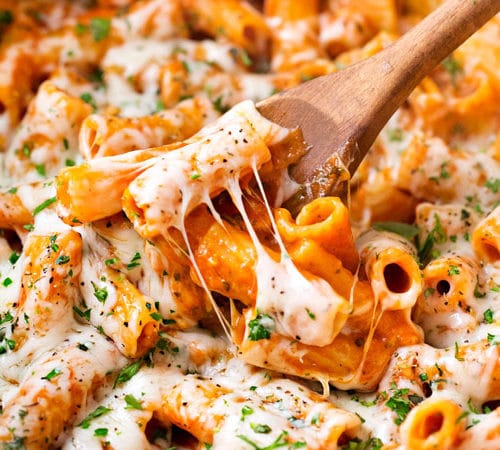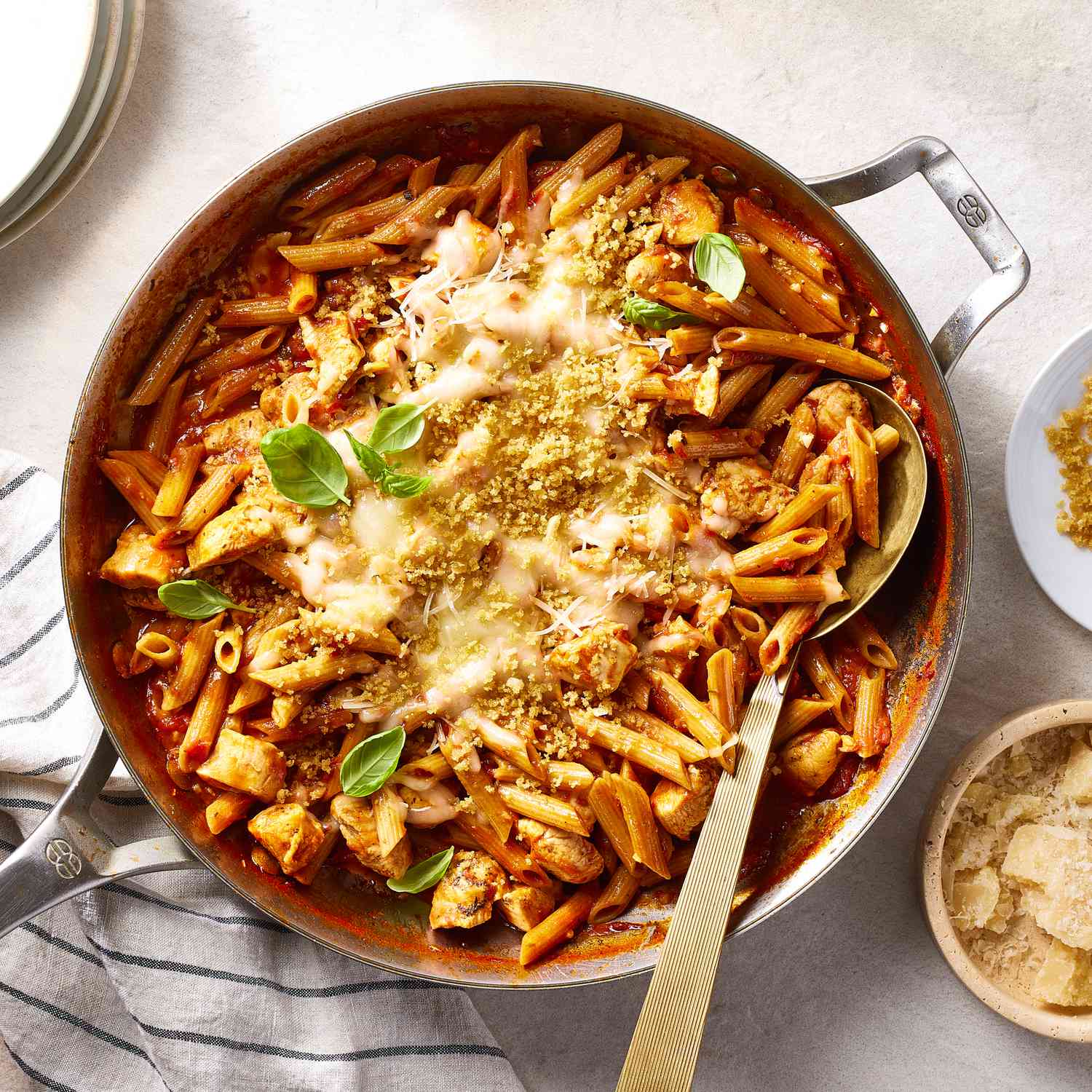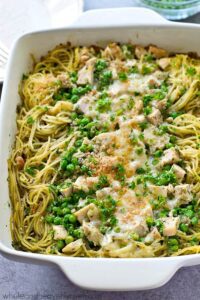One Pot Chicken Parmesan Pasta is a delicious recipe that combines amazing flavors and textures.
One Pot Chicken Parmesan Pasta revolutionizes weeknight cooking by delivering all the comfort and flavor of the classic Italian-American dish with minimal cleanup. This isn’t just simplified cooking; it’s intelligent cooking that layers flavors directly in the pot, allowing the pasta to absorb the seasoned cooking liquid and become exceptionally flavorful. Imagine tender chicken, al dente pasta, and rich tomato sauce coming together in perfect harmony, topped with melted cheese that stretches with every spoonful.
What makes this one-pot method exceptional is how the starch released from the pasta during cooking naturally thickens the sauce, creating a creamy consistency without needing additional thickeners. The chicken cooks directly in the sauce, remaining moist and absorbing the surrounding flavors. The cheese topping melts into gooey perfection under the lid, creating the signature Chicken Parmesan experience without separate baking. This approach demonstrates how thoughtful technique can yield superior results with less effort.
The Science of One-Pot Pasta Cooking
Understanding the culinary science behind one-pot pasta explains why this method works so well. As pasta cooks, it releases starch into the cooking liquid. In traditional methods, this starchy water is drained away, but in one-pot cooking, it remains and helps thicken the sauce naturally. The starch molecules swell and burst, creating a viscous liquid that coats each component beautifully.

The absorption method also means the pasta absorbs the seasoned cooking liquid rather than plain water, resulting in more flavorful pasta throughout rather than just on the surface. The liquid-to-pasta ratio is critical—too little liquid and the pasta won’t cook properly; too much and the sauce will be watery. Our tested ratio ensures perfect results every time.
Selecting and Preparing Ingredients
Pasta: Choose shapes with similar cooking times to ensure even doneness. Penne, rigatoni, ziti, and fusilli work well. Avoid delicate shapes like angel hair or orzo that may overcook. Whole wheat pasta requires slightly more liquid and longer cooking time.
Chicken: Boneless, skinless chicken breasts offer lean protein and quick cooking. For more flavor, use chicken thighs. Cut into uniform 1-inch cubes for even cooking. Pat dry before seasoning to ensure proper browning rather than steaming.

Tomato Sauce: Quality marinara makes a significant difference. Look for brands with simple ingredients—tomatoes, olive oil, garlic, herbs. For homemade flavor without much effort, enhance jarred sauce with additional herbs, garlic, or a pinch of sugar if needed.
Cheese: Freshly grated cheeses melt better than pre-shredded, which contain anti-caking agents. Parmesan adds salty umami, while mozzarella provides stretchy meltiness. For extra flavor, consider adding Asiago or Romano along with the Parmesan.
Technique Mastery for Perfect Results
Proper technique ensures your one-pot pasta succeeds every time. Brown the chicken well initially—this creates fond (caramelized bits) that adds depth to the final dish. Don’t overcrowd the chicken when browning; work in batches if necessary. Sauté aromatics until fragrant but not browned to avoid bitterness.

When adding liquid, scrape the bottom thoroughly to incorporate all the flavorful browned bits. Add pasta in an even layer and press down to submerge most pieces—some exposed is fine as steam will cook them. Stir occasionally to prevent sticking, but not too frequently as this can break the pasta. The sauce will seem thin initially but thickens significantly upon standing.
Flavor Development and Variations
The basic recipe provides a perfect foundation for creative variations. Consider these flavor enhancements: (1) Add sautéed mushrooms with the onions for earthy depth. (2) Include spinach or kale during the last 5 minutes of cooking. (3) Stir in roasted red peppers or sun-dried tomatoes for complexity. (4) Add Italian sausage instead of or with chicken for different protein.
For spice lovers, increase red pepper flakes or add a splash of hot sauce. For herbaceous notes, stir in pesto at the end. For creamier sauce, increase the cream or add cream cheese. For dairy-free, omit cream and use nutritional yeast instead of Parmesan.
Structural Considerations and Problem Solving
One-pot pasta can present specific challenges. If sauce is too thin after cooking, simmer uncovered for a few additional minutes to reduce. If too thick, stir in additional broth or water a tablespoon at a time. If pasta isn’t cooking evenly, stir more frequently and ensure heat is at proper simmer, not boil.
If bottom is sticking or burning, reduce heat and add a splash of liquid. For perfectly melted cheese topping, cover the pot after adding cheese and let residual heat melt it rather than applying direct heat. If making ahead, note that pasta will continue absorbing liquid—have extra broth available when reheating.
Presentation and Serving Suggestions
Presentation transforms this humble one-pot meal into something special. Serve directly from the pot for family-style dining. Garnish with fresh basil, parsley, or microgreens for color contrast. Additional grated cheese at the table allows customization.
Accompany with garlic bread for soaking up sauce and a simple green salad to cut the richness. For wine pairing, choose medium-bodied reds like Chianti or Sangiovese that complement the tomato sauce without overwhelming. For white wine lovers, Pinot Grigio or Verdicchio work well.
Storage and Reheating Tips
Leftovers store well for 3-4 days refrigerated in airtight containers. The pasta will continue absorbing liquid, so sauce will thicken upon standing. When reheating, add a splash of broth or water to restore sauciness. Reheat gently on stove-top or in microwave, stirring occasionally.
This dish doesn’t freeze well due to the dairy content and pasta texture changes. For make-ahead convenience, prepare components separately and combine when ready to serve, or use the stovetop-to-oven method if your pot is oven-safe.
Nutritional Considerations and Modifications
While comforting, this dish can be modified for various dietary needs. Use whole wheat or legume-based pasta for added fiber and protein. Increase vegetables by adding zucchini, bell peppers, or spinach. Reduce cheese or use part-skim varieties for lower fat content.
For gluten-free needs, use gluten-free pasta and ensure broth and other ingredients are gluten-free. For dairy-free, omit cream and cheese, using nutritional yeast for cheesy flavor. For lower sodium, use low-sodium broth and sauce, and reduce added salt.
The Evolution of One-Pot Cooking
One-pot cooking has ancient origins but has gained recent popularity as busy home cooks seek efficiency without sacrificing flavor. The method reflects modern cooking values: minimal cleanup, maximum flavor, and adaptable recipes. This approach also aligns with contemporary interest in cooking techniques that respect ingredients and their natural properties.
The specific combination of chicken Parmesan flavors in one-pot form represents innovation within tradition—honoring classic flavors while adapting preparation method for modern lifestyles. This evolution demonstrates how culinary traditions remain vibrant through adaptation rather than rigid preservation.
Final Thoughts
One Pot Chicken Parmesan Pasta represents more than just a convenient recipe—it embodies the intelligent application of cooking science to create delicious results with minimal effort. Mastering this method provides skills transferable to countless other dishes. Most importantly, it brings the comfort of classic flavors to your table with the practicality modern life demands. May it become a cherished part of your weeknight rotation for years to come.

One Pot Chicken Parmesan Pasta
Ingredients
Method
- Season chicken cubes with salt and pepper
- Heat olive oil in large pot or Dutch oven over medium-high heat
- Add chicken and cook until browned on all sides, about 5-6 minutes
- Remove chicken and set aside
- Add onion to same pot and cook until softened, about 3-4 minutes
- Add garlic and red pepper flakes, cook until fragrant, about 1 minute
- Stir in tomato paste and cook for 1 minute
- Return chicken to pot with any accumulated juices
- Add marinara sauce, chicken broth, cream, oregano, and basil
- Stir in uncooked pasta, making sure it’s submerged in liquid
- Bring to boil, then reduce heat to medium-low and cover
- Simmer for 15-18 minutes, stirring occasionally, until pasta is al dente
- Stir in Parmesan cheese until melted and creamy
- Top with mozzarella and additional Parmesan
- Cover and let stand for 2-3 minutes until cheese melts
- Garnish with fresh basil or parsley before serving



